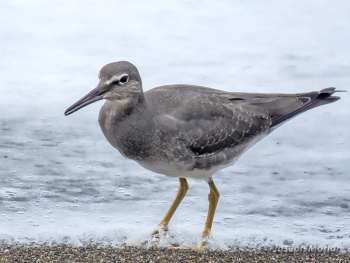- Tringa incana
Heteroscelus incanus
Identification

Photo © by Joseph Morlan
Pacifica, San Mateo County, California, USA, 5 September 2016
Length 28cm (11"), Wingspan 66cm (26"), wt. 110gm.
A shorebird with short yellow legs, a plain gray back.
In breeding season (Apr-Oct) the adult bird has heavy barring on the underside, from cheeks to tail.
Nonbreeding birds lack the barring, and have gray flanks and breast, with the remainder of the underside white. Juvenile plumage is similar to nonbreeding adult, but distinguished by narrow white fringing to wing coverts and tertials.
Similar Species
Grey-tailed Tattler is similar but in breeding plumage has reduced barring on its underparts especially its undertail coverts which are usually unmarked. At close range nasal groove extends to mid-point on bill of Wandering but shorter on Grey-tailed. But this is very difficult to see and the nasal groove should not be confused with the nostril. Otherwise best distinguished by call which is a series of hollow whistled notes in Wandering Tattler compared to more plover-liked slurred whistles for Grey-tailed.
Distribution
Winter: Western coastal North America from upper latitudes of California through Mexico.
Summer: Alaska.

Photo © by Joseph Morlan
Pacifica, San Mateo County, California, USA, 3 September 2020
Taxonomy
Formerly placed in the genus Heteroscelus but now merged in Tringa[1][2]
Subspecies
This is a monotypic species[1].
Habitat
Rocky coasts.
Behaviour
Usually solitary.
Actions
Forages along rocky shores often teetering its tail in the manner of a Spotted Sandpiper or Common Sandpiper
Diet
Mostly invertebrates especially marine invertebrates, aquatic insects; also small fish.
Breeding
Nests along mountain streams. Nest is a shallow depression. Clutch of four (sometimes 3) olive colored eggs spotted with dusky mostly at the larger end.
Vocalisation
Three distinct classes have been described: rippled trills, piping calls, and rhythmically repeated calls. Flight call is a series of hollow whistles.
Movements
Highly migratory. Some cross the ocean towards Hawaiian Islands, others migrate along the coast on both sides of the Pacific crossing the equator to South America and Australia.
References
- Clements, J. F., T. S. Schulenberg, M. J. Iliff, S. M. Billerman, T. A. Fredericks, B. L. Sullivan, and C. L. Wood. 2019. The eBird/Clements Checklist of Birds of the World: v2019. Downloaded from http://www.birds.cornell.edu/clementschecklist/download/
- Sibley, CG and BL Monroe. 1996. Birds of the World, on diskette, Windows version 2.0. Charles G. Sibley, Santa Rosa, CA, USA.
- Gill, Robert E., Brian J. McCaffery and Pavel S. Tomkovich. (2002). Wandering Tattler (Tringa incana), The Birds of North America (P. G. Rodewald, Ed.). Ithaca: Cornell Lab of Ornithology; Retrieved from the Birds of North America: https://birdsna.org/Species-Account/bna/species/wantat1
- Chandler, R. (2009). Shorebirds of North America, Europe, and Asia: A photographic guide. Princeton.
- Van Gils, J., Wiersma, P. & Kirwan, G.M. (2019). Wandering Tattler (Tringa incana). In: del Hoyo, J., Elliott, A., Sargatal, J., Christie, D.A. & de Juana, E. (eds.). Handbook of the Birds of the World Alive. Lynx Edicions, Barcelona. (retrieved from https://www.hbw.com/node/53915 on 16 August 2019).
Recommended Citation
- BirdForum Opus contributors. (2025) Wandering Tattler. In: BirdForum, the forum for wild birds and birding. Retrieved 11 May 2025 from https://www.birdforum.net/opus/Wandering_Tattler
External Links
GSearch checked for 2020 platform.




